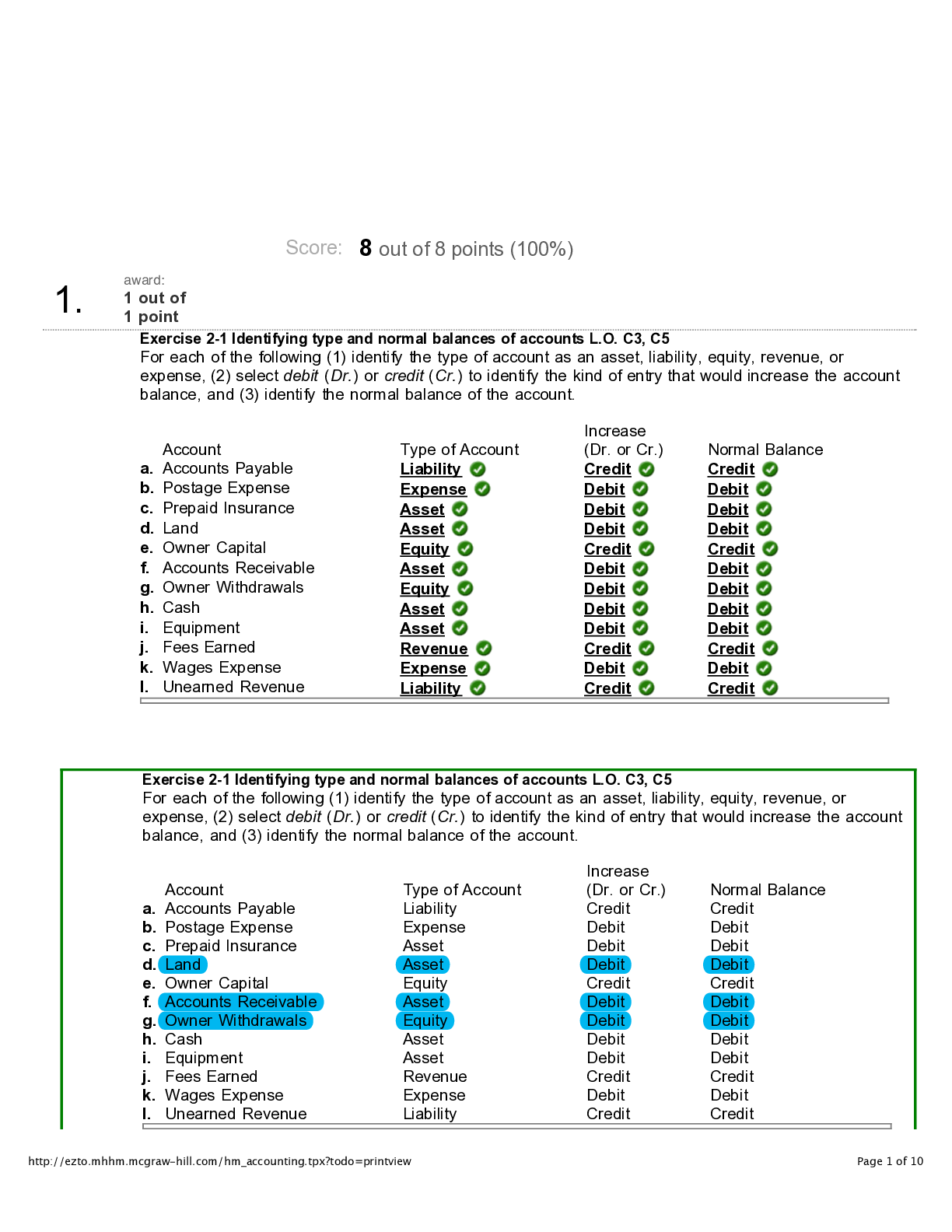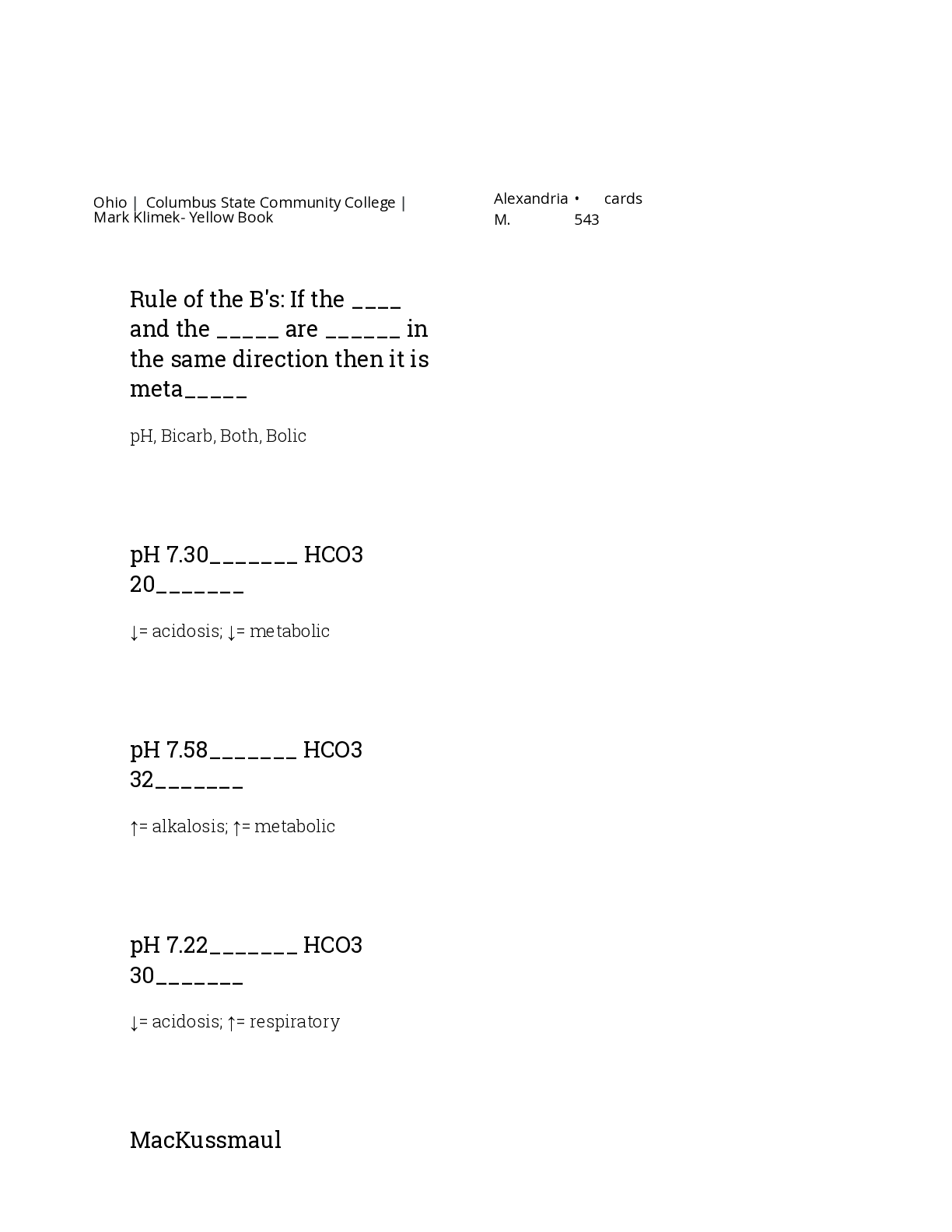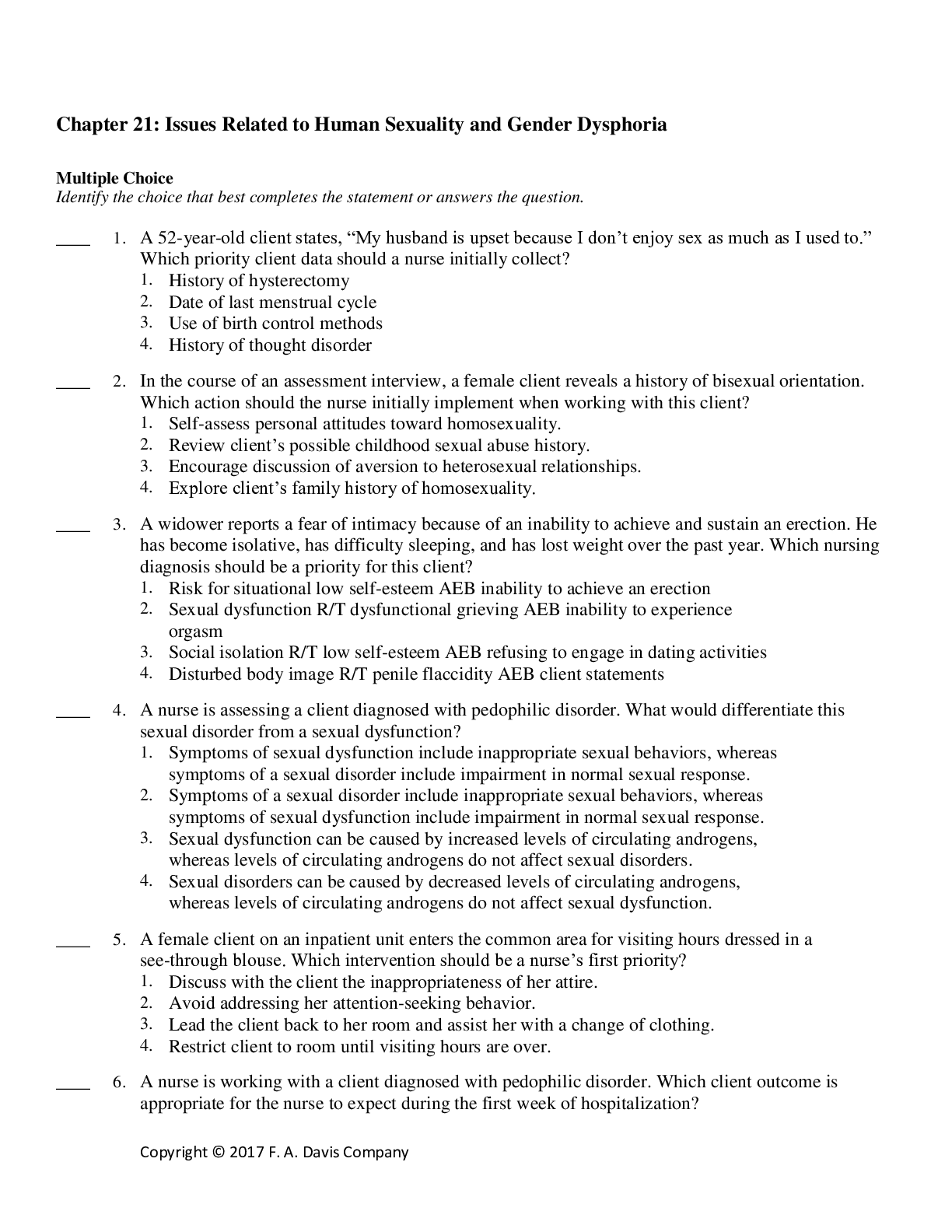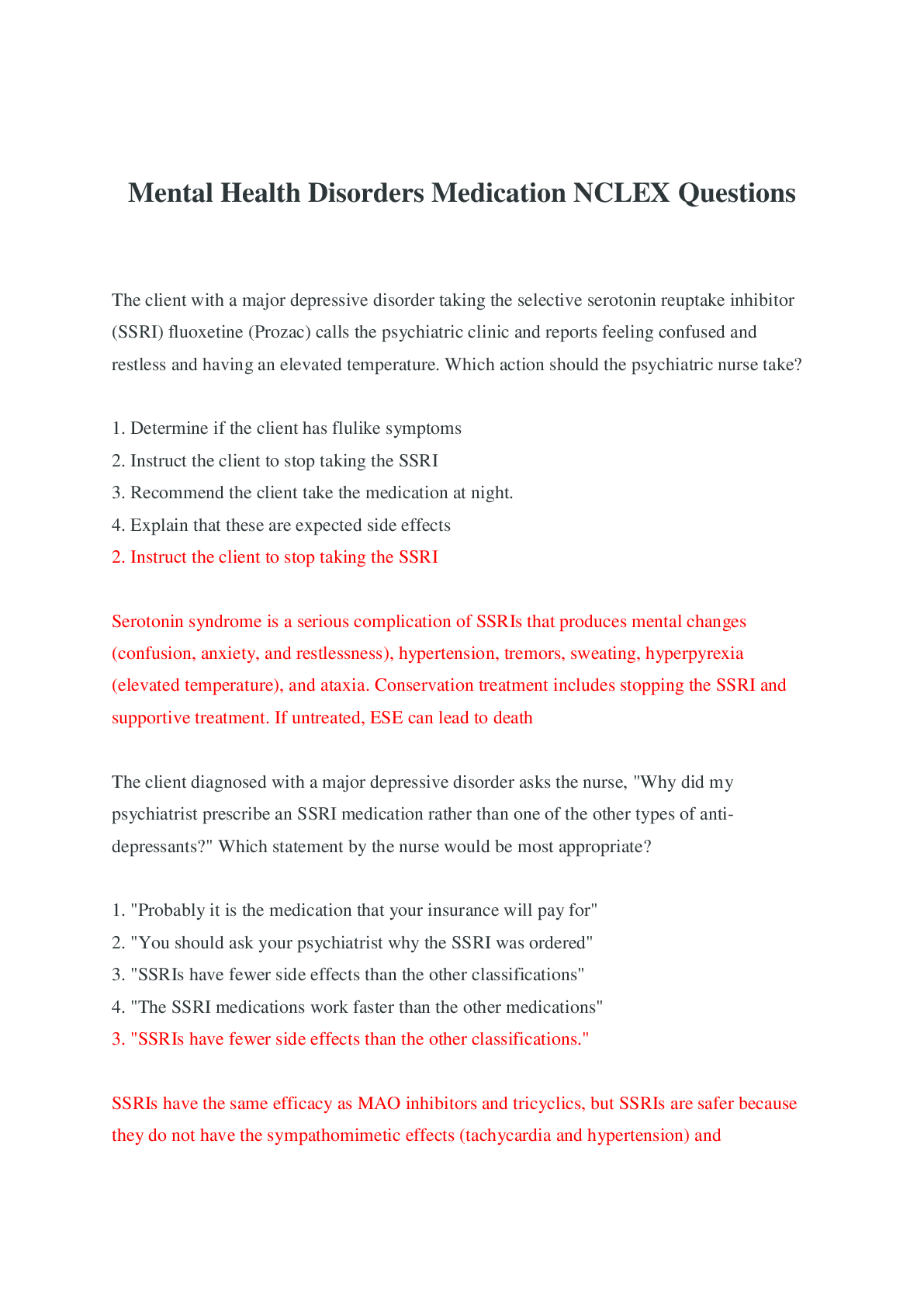*NURSING > QUESTIONS & ANSWERS > FINAL: Pharmacology NCLEX Questions. Graded A. With Answers Explained. (All)
FINAL: Pharmacology NCLEX Questions. Graded A. With Answers Explained.
Document Content and Description Below
FINAL: Pharmacology NCLEX Questions A client who has been newly diagnosed with diabetes mellitus has been stabilized with daily insulin injections. Which information should the nurse teach when c... arrying out plans for discharge? 1. Keep insulin vials refrigerated at all times. 2. Rotate the insulin injection sites systematically. 3. Increase the amount of insulin before unusual exercise. 4. Monitor the urine acetone level to determine the insulin dosage. A nurse is reinforcing teaching for a client regarding how to mix regular insulin and NPH insulin in the same syringe. Which of the following actions, if performed by the client, indicates the need for further teaching? 1. Withdraws the NPH insulin first 2. Withdraws the regular insulin first 3. Injects air into NPH insulin vial first 4. Injects an amount of air equal to the desired dose of insulin into the vial A home care nurse visits a client recently diagnosed with diabetes mellitus who is taking Humulin NPH insulin daily. The client asks the nurse how to store the unopened vials of insulin. The nurse tells the client to: 1. Freeze the insulin. 2. Refrigerate the insulin. 3. Store the insulin in a dark, dry place. 4. Keep the insulin at room temperature. A client is taking Humulin NPH insulin daily every morning. The nurse reinforces instructions for the client and tells the client that the most likely time for a hypoglycemic reaction to occur is: 1. 2 to 4 hours after administration 2. 4 to 12 hours after administration 3. 16 to 18 hours after administration 4. 18 to 24 hours after administration . A client has been taking isoniazid (INH) for 2 months. The client complains to a nurse about numbness, paresthesias, and tingling in the extremities. The nurse interprets that the client is experiencing: 1. Hypercalcemia 2. Peripheral neuritis 3. Small blood vessel spasm 4. Impaired peripheral circulation A client is to begin a 6-month course of therapy with isoniazid (INH). A nurse plans to teach the client to: 1. Drink alcohol in small amounts only. 2. Report yellow eyes or skin immediately. 3. Increase intake of Swiss or aged cheeses. 4. Avoid vitamin supplements during therapy. A client has been started on long-term therapy with rifampin (Rifadin). A nurse teaches the client that the medication: 1. Should always be taken with food or antacids 2. Should be double-dosed if one dose is forgotten 3. Causes orange discoloration of sweat, tears, urine, and feces 4. May be discontinued independently if symptoms are gone in 3 months A client with tuberculosis is being started on antituberculosis therapy with isoniazid (INH). Before giving the client the first dose, a nurse ensures that which of the following baseline studies has been completed? 1. Electrolyte levels 2. Coagulation times 3. Liver enzyme levels 4. Serum creatinine level A nurse reinforces discharge instructions to a postoperative client who is taking warfarin sodium (Coumadin). Which statement, if made by the client, reflects the need for further teaching? 1. "I will take my pills every day at the same time." 2. "I will be certain to avoid alcohol consumption." 3. "I have already called my family to pick up a Medic-Alert bracelet." 4. "I will take Ecotrin (enteric-coated aspirin) for my headaches because it is coated." Heparin sodium is prescribed for the client. The nurse expects that the health care provider will prescribe which of the following to monitor for a therapeutic effect of the medication? 1. Hematocrit level 2. Hemoglobin level 3. Prothrombin time (PT) 4. Activated partial thromboplastin time (aPTT) . Trimethoprim-sulfamethoxazole (TMP-SMZ) is prescribed for a client. A nurse should instruct the client to report which symptom if it developed during the course of this medication therapy? 1. Nausea 2. Diarrhea 3. Headache 4. Sore throat Phenytoin (Dilantin), 100 mg orally three times daily, has been prescribed for a client for seizure control. The nurse reinforces instructions regarding the medication to the client. Which statement by the client indicates an understanding of the instructions? 1. "I will use a soft toothbrush to brush my teeth." 2. "It's all right to break the capsules to make it easier for me to swallow them." 3. "If I forget to take my medication, I can wait until the next dose and eliminate that dose." 4. "If my throat becomes sore, it's a normal effect of the medication and it's nothing to be concerned about." A client is taking phenytoin (Dilantin) for seizure control and a sample for a serum drug level is drawn. Which of the following indicates a therapeutic serum drug range? 1. 5 to 10 mcg/mL 2. 10 to 20 mcg/mL 3. 20 to 30 mcg/mL 4. 30 to 40 mcg/mL A nurse is caring for a client who is taking phenytoin (Dilantin) for control of seizures. During data collection, the nurse notes that the client is taking birth control pills. Which of the following information should the nurse provide to the client? 1. Pregnancy should be avoided while taking phenytoin (Dilantin). 2. The client may stop taking the phenytoin (Dilantin) if it is causing severe gastrointestinal effects. 3. The potential for decreased effectiveness of the birth control pills exists while taking phenytoin (Dilantin). 4. The increased risk of thrombophlebitis exists while taking phenytoin (Dilantin) and birth control pills together. A client with trigeminal neuralgia is being treated with carbamazepine (Tegretol). Which laboratory result would indicate that the client is experiencing an adverse reaction to the medication? 1. Sodium level, 140 mEq/L 2. Uric acid level, 5.0 mg/dL 3. White blood cell count, 3000 cells/mm3 4. Blood urea nitrogen (BUN) level, 15 mg/dL Cyclobenzaprine (Flexeril) is prescribed for a client to treat muscle spasms, and the nurse is reviewing the client's record. Which of the following disorders, if noted in the client's record, would indicate a need to contact the health care provider regarding the administration of this medication? 1. Glaucoma 2. Emphysema 3. Hyperthyroidism 4. Diabetes mellitus A nurse is collecting data from a client and the client's spouse reports that the client is taking donepezil hydrochloride (Aricept). Which disorder would the nurse suspect that this client may have based on the use of this medication? 1. Dementia 2. Schizophrenia 3. Seizure disorder 4. Obsessive-compulsive disorder Fluoxetine (Prozac) is prescribed for the client. The nurse reinforces instructions to the client regarding the administration of the medication. Which statement by the client indicates an understanding about administration of the medication? 1. "I should take the medication with my evening meal." 2. "I should take the medication at noon with an antacid." 3. "I should take the medication in the morning when I first arise." 4. "I should take the medication right before bedtime with a snack." A client receiving a tricyclic antidepressant arrives at the mental health clinic. Which observation indicates that the client is correctly following the medication plan? 1. Reports not going to work for this past week 2. Complains of not being able to "do anything" anymore 3. Arrives at the clinic neat and appropriate in appearance 4. Reports sleeping 12 hours per night and 3 to 4 hours during the day A nurse is performing a follow-up teaching session with a client discharged 1 month ago who is taking fluoxetine (Prozac). What information would be important for the nurse to gather regarding the adverse effects related to the medication? 1. Cardiovascular symptoms 2. Gastrointestinal dysfunctions 3. Problems with mouth dryness 4. Problems with excessive sweating A client arrives at the health care clinic and tells the nurse that he has been doubling his daily dosage of bupropion hydrochloride (Wellbutrin) to help him get better faster. The nurse understands that the client is now at risk for which of the following? 1. Insomnia 2. Weight gain 3. Seizure activity 4. Orthostatic hypotension A client received 20 units of NPH insulin subcutaneously at 8:00 AM. The nurse should check the client for a potential hypoglycemic reaction at what time? 1. 5:00 PM 2. 10:00 AM 3. 11:00 AM 4. 11:00 PM A nurse is providing instructions to an adolescent who has a history of seizures and is taking an anticonvulsant medication. Which of the following statements indicates that the client understands the instructions? 1. "I will never be able to drive a car." 2. "My anticonvulsant medication will clear up my skin." 3. "I can't drink alcohol while I am taking my medication." 4. "If I forget my morning medication, I can take two pills at bedtime." Intravenous heparin therapy is prescribed for a client. While implementing this prescription, a nurse ensures that which of the following medications is available on the nursing unit? 1. Protamine sulfate 2. Potassium chloride 3. Phytonadione (vitamin K ) 4. Aminocaproic acid (Amicar) Carbamazepine (Tegretol) is prescribed for a client with a diagnosis of psychomotor seizures. The nurse reviews the client's health history, knowing that this medication is contraindicated if which of the following disorders is present? 1. Headaches 2. Liver disease 3. Hypothyroidism 4. Diabetes mellitus A nurse provides dietary instructions to a client who will be taking warfarin sodium (Coumadin). The nurse tells the client to avoid which food item? 1. Grapes 2. Spinach 3. Watermelon 4. Cottage cheese A client with multiple sclerosis is receiving diazepam (Valium), a centrally acting skeletal muscle relaxant. Which of the following would indicate that the client is experiencing a side effect related to this medication? 1. Headache 2. Drowsiness 3. Urinary retention 4. Increased salivation A client with epilepsy is taking the prescribed dose of phenytoin (Dilantin) to control seizures. A phenytoin blood level is drawn, and the results reveal a level of 35 mcg/ml. Which of the following symptoms would be expected as a result of this laboratory result? 1. Nystagmus 2. Tachycardia 3. Slurred speech 4. No symptoms, because this is a normal therapeutic level A health care provider initiates carbidopa/levodopa (Sinemet) therapy for the client with Parkinson's disease. A few days after the client starts the medication, the client complains of nausea and vomiting. The nurse tells the client that: 1. Taking an antiemetic is the best measure to prevent the nausea. 2. Taking the medication with food will help to prevent the nausea. 3. This is an expected side effect of the medication and will decrease over time. 4. The nausea and vomiting will decrease when the dose of levodopa is stabilized. *eliminate options 3 and 4 because they are comparable or alike* A nurse has administered a dose of diazepam (Valium) to a client. The nurse would take which important action before leaving the client's room? 1. Giving the client a bedpan 2. Drawing the shades or blinds closed 3. Turning down the volume on the television 4. Per agency policy, putting up the side rails on the bed A tricyclic antidepressant is administered to a client daily. The nurse plans to monitor for the common side effects of the medication and includes which of the following in the plan of care? 1. Offer hard candy or gum periodically. 2. Offer a nutritious snack between meals. 3. Monitor the blood pressure every 2 hours. 4. Review the white blood cell (WBC) count results daily. A client is being treated for depression with amitriptyline hydrochloride. During the initial phases of treatment, the most important nursing intervention is: 1. Prescribing the client a tyramine-free diet 2. Checking the client for anticholinergic effects 3. Monitoring blood levels frequently because there is a narrow range between therapeutic and toxic blood levels of this medication 4. Getting baseline postural blood pressures before administering the medication and each time the medication is administered A client taking carbamazepine (Tegretol) asks the nurse what to do if he misses one dose. The nurse responds that the carbamazepine should be: 1. Withheld until the next scheduled dose 2. Withheld and the health care provider is notified immediately 3. Taken as long as it is not immediately before the next dose 4. Withheld until the next scheduled dose, which should then be doubled [Show More]
Last updated: 2 years ago
Preview 1 out of 19 pages

Buy this document to get the full access instantly
Instant Download Access after purchase
Buy NowInstant download
We Accept:

Reviews( 0 )
$7.00
Can't find what you want? Try our AI powered Search
Document information
Connected school, study & course
About the document
Uploaded On
Feb 02, 2020
Number of pages
19
Written in
Additional information
This document has been written for:
Uploaded
Feb 02, 2020
Downloads
0
Views
134


.png)
.png)
.png)
.png)
.png)
.png)
.png)







